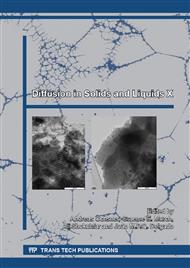p.106
p.112
p.116
p.122
p.128
p.136
p.142
p.148
p.154
The Percolation Phenomenon and Fractal Dimension of Natural Silicates
Abstract:
Many physical effects, such as dc conductivity and percolation, depend on the morphology of the silicate structure and its relationship to adsorbed water. These effects play an important role in numerous technological applications, in geology, oil-extracting industry, and other practical fields. In this study, all the samples: natural montmorillonite, kaolinite, and сlinoptilolite with different exchangeable cations in their structures, – were stored in ambient air humidity. The investigation was carried by using two separate techniques, namely Dielectric Spectroscopy and a fractal analysis of electron micrographs. The aims of this work were to analyze the complex relaxation behavior of the relaxation process in temperature range –70°C ÷ +70°C and to determine the fractal dimensions of silicates from the dielectric response at percolation. Dielectric measurements in the frequency range of 1 Hz ÷ 1 MHz were performed using a BDS 80 Dielectric Spectrometer based on an Alpha Impedance Analyzer (Novocontrol). The micrographs were analyzed using a special Matlab based program. The analysis of aspects of the dielectric relaxation spectra related to percolation was used for the determination of the numerical characteristics of geometric heterogeneity of natural silicates. The percolation temperatures of the studied samples were determined. The percolation phenomenon in the silicates is related to the transfer of the electric excitation within the developed network of open pores due to the migration of protons and ions along the surface of connected pores on the outer surfaces of the granules. The analysis of these processes allows one to extract the fractal dimensions associated with the migration of charge carriers within the porous medium. Fractal dimensions of the silicates calculated in two ways: from dielectric spectroscopy study and from fractal analysis of the micrographs, – are in good agreement with each other. It was demonstrated that conventional method of the spatial fractal dimension determination using fractal analysis of electron micrographs leads to overestimation in the case of spatial fractal bounded by a surface fractal. The dielectric spectroscopy method is free from such overestimation.
Info:
Periodical:
Pages:
128-135
Citation:
Online since:
July 2015
Authors:
Price:
Сopyright:
© 2015 Trans Tech Publications Ltd. All Rights Reserved
Share:
Citation:


